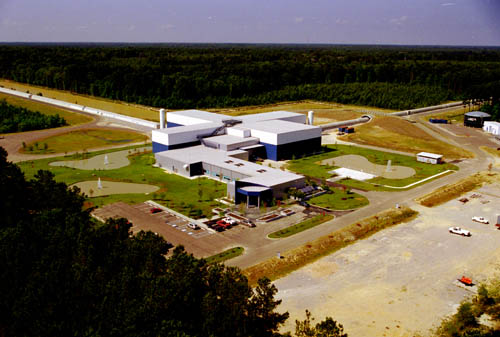Gravitational wave bursts from core collapse supernovae |
|
New computer simulations carried out at the Max Planck Institute for Astrophysics predict expected signals for gravitational wave detectors.
Whereas light or sound waves propagate trough spacetime, gravitational waves are propagating ripples of spacetime itself. Such distortions in spacetime, which can be measured as a periodic shift in the length of a suitably chosen "measuring rod" are generated by aspherical concentrations of moving matter. However, as this effect is so small, even the most violent astrophysical phenomena involving extremely compact objects (like e.g. colliding and merging black holes or neutron stars, or collapsing stars) emit gravitational waves which, given the typical distance to the event, manifest themselves as a tiny relative shift of only 10-20 on Earth.Not surprisingly, although gravitational waves have been predicted by Albert Einstein in his theory of general relativity over 80 years ago, only now technology enables physicists to tackle the problem of detecting them. One detector type are large laser interferometers which are currently being completed in various countries (see figure 1). Even in the largest detectors, a prospective detection of a gravitational wave translates into a measurement of a distance which is only about 1/100th of the size of an atomic nucleus! No length measurement has ever been attempted before to such an unprecedented precision. A successful direct detection of gravitational waves, which can be envisaged within the next 5 years, will not only unequivocally prove Einstein's bold prediction (which today is not seriously doubted anymore), but even more interestingly, will open a completely new "window" onto the universe. By routinely observing gravitational waves, astrophysicists will gain new and otherwise entirely unattainable insights into such fascinating objects like black holes, the enigmatic cosmic gamma ray bursts, or the driving engines behind stellar supernova explosions [Thorne, 1997].

|
| Figure 1: Aerial view of the LIGO gravitational wave observatory site located at Livingston, U.S.A.; the two interferometer arms (serving as ``measuring rods'' for probing spacetime), which extend to a length of 4 km, are spreading out from the central building to the left and right upper corners of the photograph. Similar detectors are being built in Hanford, U.S.A. (LIGO), in Pisa, Italy (VIRGO), in Hannover, Germany (GEO 600), in Tokyo, Japan (TAMA 300), and in Perth, Australia (ACIGA). There is a close international cooperation between the research groups which are building these detectors. |
As the detection of gravitational waves is such a difficult task, very efficient electronic filters have to be employed to extract a possible signal from the data measured by a detector [Arnaud et al., 1998]. In order to find this "needle in a haystack", people working in data analysis have to know the form of the prospective gravitational wave signal as precisely as possible. It is therefore of great importance to predict signals from theoretical models (so called wave templates) of various astrophysical sources of gravitational radiation. Moreover, by comparing the predicted signals with those actually detected, astrophysicists can test and constrain their models and eventually gain a better understanding of the fundamental physical processes which govern the event.
One example of a promising source of gravitational waves is the gravitational collapse of the rapidly rotating core of a massive star to a neutron star and the subsequent explosion of the star in a spectacular supernova event: Within fractions of a second a mass larger than that of our sun is compressed during the collapse to densities exceeding 100 millions of tons per cubic centimetre. The gravitational-wave signals produced typically consist of a strong short burst with a complicated temporal structure, and they depend crucially on many aspects of the complicated physics involved in this powerful event.
Performing large-scale computer simulations, researchers at the Max Planck Institute for Astrophysics have been modelling stellar core collapse with increasing complexity for many years [Mönchmeyer et al., 1991, Zwerger & Müller, 1997, Rampp, Müller & Ruffert, 1998]. Although not yet realistic enough to provide detailed wave-templates, these simulations indicate that gravitational wave signals from supernovae in our Galaxy are strong enough (but unfortunately not as strong as previously thought) to be detectable by the new detectors which are soon operational (see figure 2).
Extending these simulations, a group of scientists at the Max Planck Institute for Astrophysics have recently succeded for the first time to simulate the collapse of a rotating stellar core to a neutron star including the effects of general relativity [Dimmelmeier et al., 2001], making a major step towards realistic predictions of gravitational wave signals. Figure 3 shows the computed signal for a typical rotating core collapse model. A comparison between the previous Newtonian simulation (red line) and the new improved general relativistic simulation (blue line) clearly reveals a qualitative change of the signal form. This demonstrates that improvements in the physical model underlying the numerical simulation - though a priori considered to be of rather modest size - can have a huge impact on the gravitational wave signal.
These new simulations will help observers to identify and extract gravitational wave signals in their future measurements. Furthermore, they also allow to draw conclusions about the circumstances of the actual supernova event from a possible signal, extending far beyond the knowledge we can obtain from observations of the emitted light with conventional optical telescopes. With the gravitational wave detectors becoming fully operational in the very near future, astrophysicists are now eagerly waiting for the next supernova in our Galaxy.
Harald Dimmelmeier,
José A. Font,
Ewald Müller,
Markus Rampp.
Further information:
| MPA-Home |